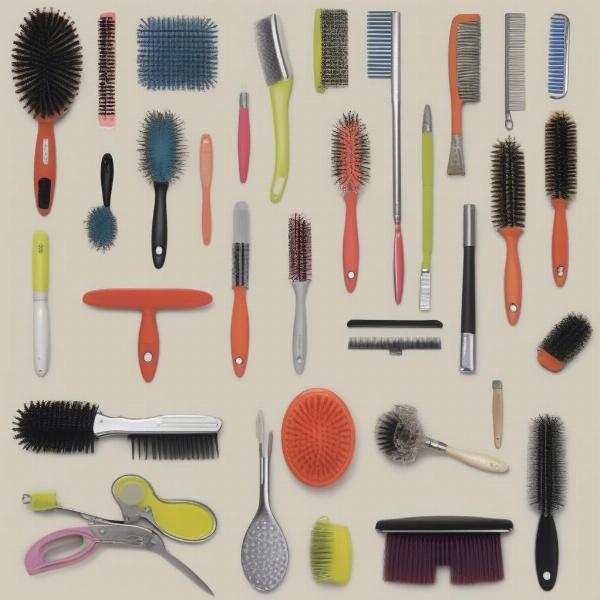A dog grooming brush is more than just a tool; it’s an essential part of your dog’s health and happiness. Regular brushing keeps your furry friend looking their best, prevents matting, reduces shedding, and strengthens your bond. But with so many different types of dog grooming brushes available, how do you choose the perfect one for your canine companion? This comprehensive guide will delve into the world of dog grooming brushes, helping you make an informed decision based on your dog’s breed, coat type, and specific needs.
 Different types of dog grooming brushes for various coat types.
Different types of dog grooming brushes for various coat types.
Understanding Your Dog’s Coat
Before diving into the different brush types, it’s crucial to understand your dog’s coat. Dogs come in a wide array of coat types, from short and smooth to long and wiry. Each coat type requires a specific kind of brush to achieve optimal results. For instance, a slicker brush might work wonders on a long-haired dog but be too harsh for a short-coated breed. Knowing your dog’s coat type is the first step in choosing the right grooming brush.
Short-Coated Breeds
Short-coated breeds, like Beagles and Boxers, benefit from bristle brushes or rubber curry combs. These help remove loose hair and distribute natural oils, leaving their coat shiny and healthy.
Long-Coated Breeds
Long-coated breeds, such as Golden Retrievers and Yorkshire Terriers, are prone to matting. Slicker brushes, pin brushes, and de-matting tools are essential for preventing tangles and keeping their flowing locks in pristine condition.
Double-Coated Breeds
Double-coated breeds, like Huskies and German Shepherds, have a dense undercoat that sheds seasonally. Rakes and de-shedding tools are specifically designed to remove loose undercoat, minimizing shedding and keeping their coat healthy.
Different Types of Dog Grooming Brushes
Navigating the world of dog grooming brushes can be overwhelming. Here’s a breakdown of the most common types and their uses:
- Bristle Brushes: Ideal for short-coated breeds, these brushes remove loose hair and distribute natural oils. Choose a brush with soft bristles for sensitive skin.
- Slicker Brushes: Perfect for long-haired breeds, these brushes have fine wire bristles that effectively remove mats and tangles.
- Pin Brushes: Similar to slicker brushes, but with rounded tips, these are gentler on the skin and suitable for dogs with sensitive skin.
- Rakes: Designed for double-coated breeds, these tools remove loose undercoat and prevent matting.
- De-Shedding Tools: These tools specifically target loose undercoat, minimizing shedding and keeping your home cleaner.
- Matt Splitters: These tools are used to carefully cut and remove mats without pulling on the dog’s skin.
How to Choose the Right Brush
Choosing the right brush depends on a combination of factors, including your dog’s breed, coat type, and individual needs. Consider the following:
- Coat Length: Short-coated breeds benefit from bristle brushes, while long-coated breeds require slicker or pin brushes.
- Coat Thickness: Double-coated breeds require rakes or de-shedding tools.
- Skin Sensitivity: Dogs with sensitive skin may require brushes with softer bristles or rounded tips.
- Shedding: If your dog sheds heavily, consider a de-shedding tool.
- Matting: Long-haired breeds prone to matting benefit from slicker brushes and de-matting tools.
Tips for Effective Brushing
- Start Early: Introduce your dog to brushing at a young age to make it a positive experience.
- Be Gentle: Always brush in the direction of hair growth, avoiding pulling or tugging.
- Regular Brushing: Regular brushing prevents matting, reduces shedding, and distributes natural oils.
- Positive Reinforcement: Reward your dog with treats and praise during and after brushing.
Conclusion
Choosing the right dog grooming brush is an essential part of responsible dog ownership. By understanding your dog’s coat type and individual needs, you can select the perfect brush to keep them looking and feeling their best. Regular brushing not only enhances their appearance but also contributes to their overall health and well-being. Remember, a grooming brush for dogs is an investment in your furry friend’s happiness and comfort.
FAQ
- How often should I brush my dog? The frequency of brushing depends on your dog’s coat type. Short-coated breeds may require weekly brushing, while long-haired breeds may need daily brushing.
- What’s the difference between a slicker brush and a pin brush? Slicker brushes have fine wire bristles for removing mats, while pin brushes have rounded tips for gentler grooming.
- Can I use a human hairbrush on my dog? No, human hairbrushes are not designed for dog coats and can damage their skin.
- How do I remove mats from my dog’s coat? Use a slicker brush, de-matting tool, or matt splitter to carefully remove mats. If the matting is severe, consult a professional groomer.
- What’s the best way to prevent matting? Regular brushing and proper coat care are the best ways to prevent matting.
- My dog hates being brushed. What can I do? Start slowly and use positive reinforcement, such as treats and praise. Make brushing a positive experience.
- How do I clean my dog’s grooming brush? Remove loose hair and wash the brush with warm, soapy water. Allow it to dry completely before using it again.
Related Articles:
About ILM Dog:
ILM Dog is your go-to resource for expert advice on dog breeds, health, training, nutrition, grooming, and much more. We provide practical, trustworthy information to help dog owners worldwide provide the best possible care for their canine companions. Whether you’re a seasoned dog owner or just starting your journey, ILM Dog is here to support you every step of the way. Contact us for personalized advice: Email: [email protected], Phone: +44 20-3965-8624.